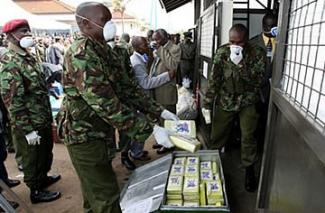Drug Trafficking in India and African Connection
The recent illegal drug hauls in various parts of India and a couple of high-profile drug abuse cases involving people in power brought the spotlight back onto illegal drug issues in the country. India’s Anti Narcotics Bureau and the Directorate of Revenue Intelligence have seized drugs ranging from cocaine to heroin and other opiates worth millions of dollars in the international market within the last few months. The fact is drug trafficking and illegal drug abuse have been taking place in the subcontinent for a very long but have been relatively ignored.
India has always been a conduit and producer of drugs. Large quantities of the chemicals (used in the Pharmaceutical industry) have been diverted to produce illegal drugs such as Mandrax and Methamphetamine, which has emerged as a major problem in countries such as South Africa and the United States. India also produces Heroin and cultivates Cannabis on a large scale. Though Heroin produced in India is not of the best quality from the end user’s perspective, the Cannabis and Hashish processed in India are highly in demand for their quality. Ample opportunities exist for drug syndicates to ply their trade in not only India but also in South Asia.
Narcotics trafficking, particularly by West Africans – mainly of Nigerian origin – has emerged as a big challenge to Indian authorities in the last few years. Recent arrests of four Nigerians in New Delhi and Cocaine seizures in Mumbai indicate that a new pattern of narcotics peddling has developed in India. Instead of traditional organized criminals, now foreign tourists are trafficking narcotics into Indian markets. In the last 17 months, over 35 Nigerians were apprehended in connection with narcotics peddling in New Delhi alone. They are active in Bangalore and Mumbai. Many Afghan nationals were also arrested on similar charges. Drug peddlers are targeting India because it is the best-connected city in South Asia, and it has the potential of a vast market.
Nigerians have been active in drug trafficking in Asia since the late 1970s. Evidence points to Nigerians being involved in drug trafficking when Nigeria suffered a severe economic crisis in the late 1970s and early 1980s. Most of the people involved are illegal immigrants with fraudulent identity documents.
Nigerians have earned the unpopular distinction of being the main players in the narcotic trafficking business and also involved in large-scale peddling rackets. They have been smuggling Heroin from Central, Southeast and Southwest Asia. The Nigerians have, over the years, established solid networks and have ready access to the infrastructure to smuggle drugs across the world. They have developed a speciality in the recruitment of couriers to transport drugs on their behalf because of the dangers associated with doing these themselves. However, some Nigerians continue to courier drugs themselves, and this is shown by some of the recent arrests made by police. The couriers tend to be people in dire financial straits. They are paid anything between 10,000 and 25,000 Rand (approx. US$1,400 and US$3,500), an amount that is difficult to resist when one is desperate for the much-needed cash, and the drug barons are taking full advantage of that.
The drug trafficking connection between South Africa and India is a long-standing one. It dates back to when India banned the production of Mandrax in the early 1970s. Mandrax used to be produced legally in India until it was recognised that the drug had a high potential of being abused. South Africa was then and still is the largest market for smuggled Mandrax, where reportedly 80 per cent of the illegal drug’s consumers reside. The Mandrax trafficking connection created the gap for Heroin to be brought in from Asia’s notorious Golden Crescent and Golden Triangle. But South Africa was never the main destination for Heroin. South Africa has been used as a conduit for Heroin (and other illegal drugs, like Cocaine) because it is well placed geographically, being located on the sea trading route to destinations such as South America, Asia, Australia, Europe and the Middle East. Top infrastructural development and the high traffic in people and goods make South Africa a perfect conduit for illegal smuggling activities. Mostly, West African drug traffickers have taken advantage of this.
There is a sense that tip-offs originate from traffickers themselves. On most occasions, the informants are never identified. The quantities seized, while they may be significant, pale in comparison to the drugs that end up in the market. Therefore, drug traffickers may be using diversion tactics to get law enforcement agencies to focus on lesser consignments while they are busy moving the heavy loads around. It is quite difficult to detect drugs moving through ports and harbours where capacity is seriously lacking. This is a universal phenomenon. The goods traffic is just too large to allow law enforcement agents to detect all suspect consignments.
Undoubtedly, illicit drugs affect various facets of people’s lives. This is through drug-related crime and multiple sorts of hazards on and off the road caused by drug intake. There is also the danger of overdose and permanent damage to the brain. Also, intravenous drug use can lead to HIV infections. To overcome the scourge, nations must unite to fight the vice. No single country can tackle the problem of illicit drugs by itself. Drug syndicates are highly networked. Therefore, law enforcement agents have to form networks of cooperation as well. However, unlike law enforcement agencies, criminal syndicates do not face the burden of going bureaucratic. Therefore, to keep up with drug syndicates, countries need to pursue measures that will allow unfettered cooperation to take place.
